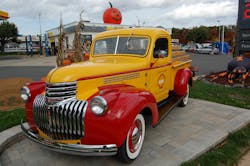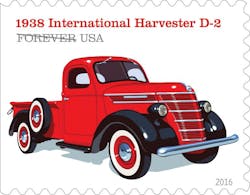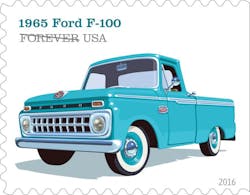Pickup trucks hold a special place all their own in the annals of America’s motorized history (go here for more images from the stamps, or here, here, and here for some photos galleries of classic pickups and other assorted vehicles from the past).
Now, to honor these rugged and reliable work vehicles driven by Americans for nearly a century, the U.S. Postal Service is issuing four new Forever stamps featuring what it describes as “iconic” pickup truck models:
- A 1938 International Harvester D-2 (seen at right) with its distinct barrel-shaped grille;
- A 1953 Chevrolet, which featured large windshields for improved visibility, plus a distinctive curvy grille that bulged in the middle along with a six-cylinder engine.
- A 1948 Ford F-1 with its sharp horizontal five-bar grille and a six cylinder engine.
- A 1965 Ford F-100 sporting a “new” grille featureing 18 small rectangular openings, along with what the OEM at the time dubbed its “Twin-I-Beam” independent front suspension.
Illustrator Chris Lyons created the stamp artwork under the direction of Antonio Alcalá honoring the pickup; a model debuted with the 1925 Ford Model T Runabout with what was then called a “pick-up body.”
A fortified version of Ford's landmark Model T, the Runabout had a base price of $281, featured a steel bed, and was powered by a 20-horsepower engine. Ford reportedly sold nearly 34,000 Model T pickups, helping kick start the popularity of pickup trucks among civilians, but reportedly Studebaker gets credit for first using the word “pickup” in an advertisement in 1913, though the exact origins of the term “pickup” – and the roots of that word as well – remains unclear.
Indeed, in 1917, Ford released the Model TT, which had a one-ton chassis and in 1918, Chevrolet introduced the Model 490 truck. But because drivers had to purchase their own cargo beds and bodies, those vehicles weren't considered “true” pickup trucks (and thus why the 1925 Model T Runabout gets pegged as the “first” pickup).
International Harvester – more known for its agricultural equipment –supplied and maintained trucks on stateside military bases during World War I, with that experience possibly leading it in the 1930s to develop its “D line” of pickups.
In the post-World War II era, more “luxury” refinements began being added to what up until then were “bare bones” pickup models.
In 1947, Chevrolet rolled out its Advance-Design Series that lays claim to being the first all-new post-World War II pickup truck line – a line that eventually became some of America's top-selling pickups for nearly a decade.
Not to be outdone, International Harvester also introduced new pickups around this time, specifically the KB-Series.
Ford also rolled out a new model during the post-war years, one that would become its “signature” pickup truck offering: the F-Series. Also known as the “Bonus Built” line, the 1948 Ford F-1 offered what was then called a “Million Dollar Cab” due to its roominess, a sharp horizontal five-bar grille, and either a six- or eight-cylinder engine.
International Harvester didn’t sit idly by during this period, adding a crew cab option in 1957 and then going on to roll out new pickup models in the 1960s and 1970s: the Scout and C-Series models.
For the 1965 model year, Ford gave its F-Series pickup a facelift, with the 1965 Ford F-100 sporting that new grille noted earlier, featuring 18 small rectangular openings.
By the by, as of 2015, there have been 13 generations of F-Series pickups, according to Ford.
Talk about longevity! One only wonders what the next 100 years may bring in terms of pickup truck design and development.
About the Author
Sean Kilcarr
Editor in Chief
Sean Kilcarr is a former longtime FleetOwner senior editor who wrote for the publication from 2000 to 2018. He served as editor-in-chief from 2017 to 2018.


